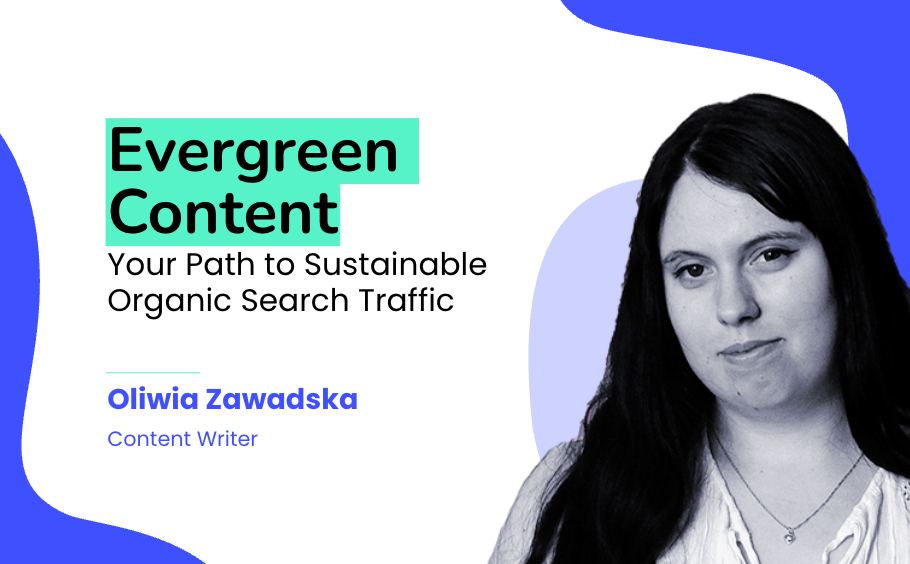Learn how to generate sustainable organic search traffic by researching and creating evergreen content.
Evergreen Content: Your Path to Sustainable Organic Search Traffic
Author: Oliwia Zawadzka, Content Writer

Content can be categorised into two types based on longevity: trending, tied to current events and likely to lose relevance, and evergreen, remaining relevant over time.
What Is Evergreen Content?
Evergreen content is content that does not lose relevance and that continues to sustain interest irrespective of how long ago it was published. Great examples of such content are “how-to” guides or lists of tips, although it’s important to remember that not every article that has this format can be considered to be evergreen.
How to Create Evergreen Content
When creating evergreen content, finding the right topics and keywords is crucial, as they will be the determining factor in whether your content can be considered evergreen.
Step 1: Find Evergreen Keywords & Topics
Here’s a breakdown of how to find evergreen keywords using Ahrefs and Google Trends..
- Log into Ahrefs and go to the Keywords Explorer tab.
- Enter a keyword relevant to your website.
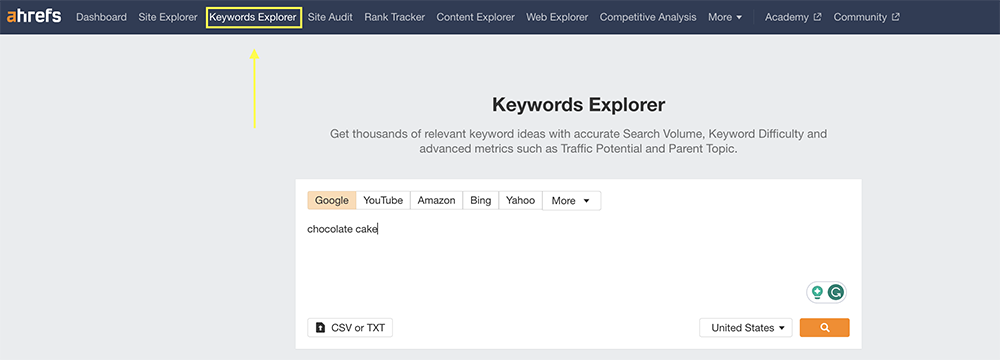
- Navigate to the “Matching Terms” section of the page. When looking for keywords to include in your content, pay attention to how the search volume has changed over time – it’s best to go for keywords that have consistent search volumes, with less traffic than those with a high traffic potential, but search demand is inconsistent.
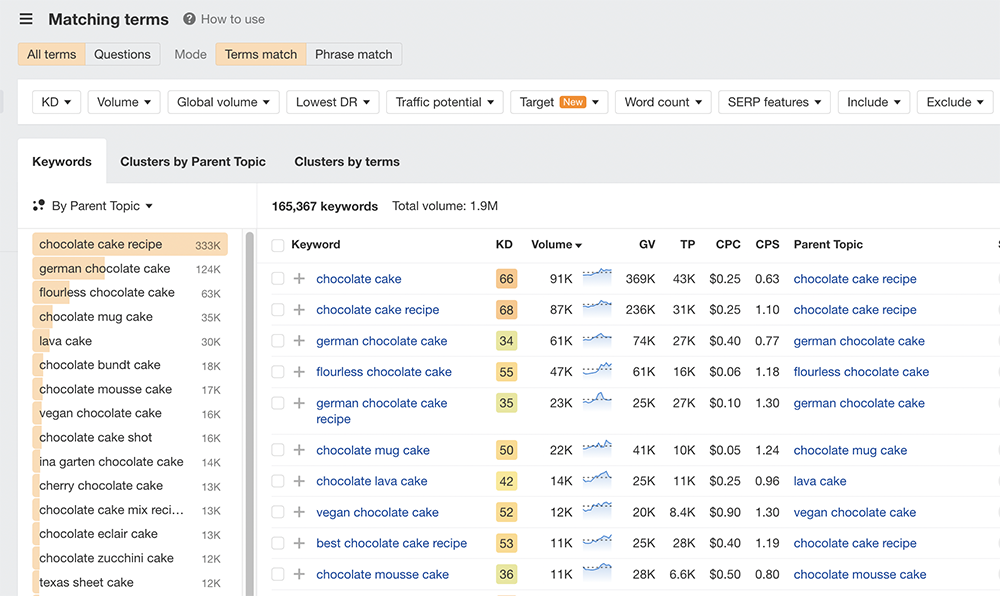
For example, the keyword “chocolate cake” is an evergreen keyword – despite some fluctuations, the search interest over time remained generally stable.
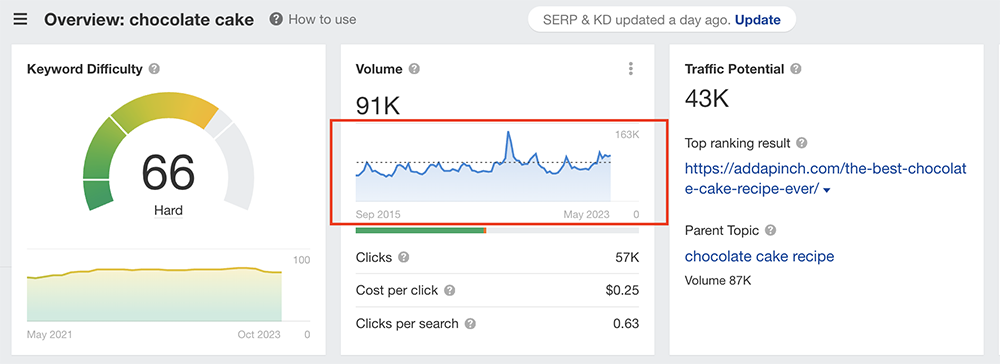
To verify whether a keyword is evergreen, you can also check it using Google Trends.
In this case, we can see that the interest for “chocolate cake” over the past few years, has remained mostly consistent.
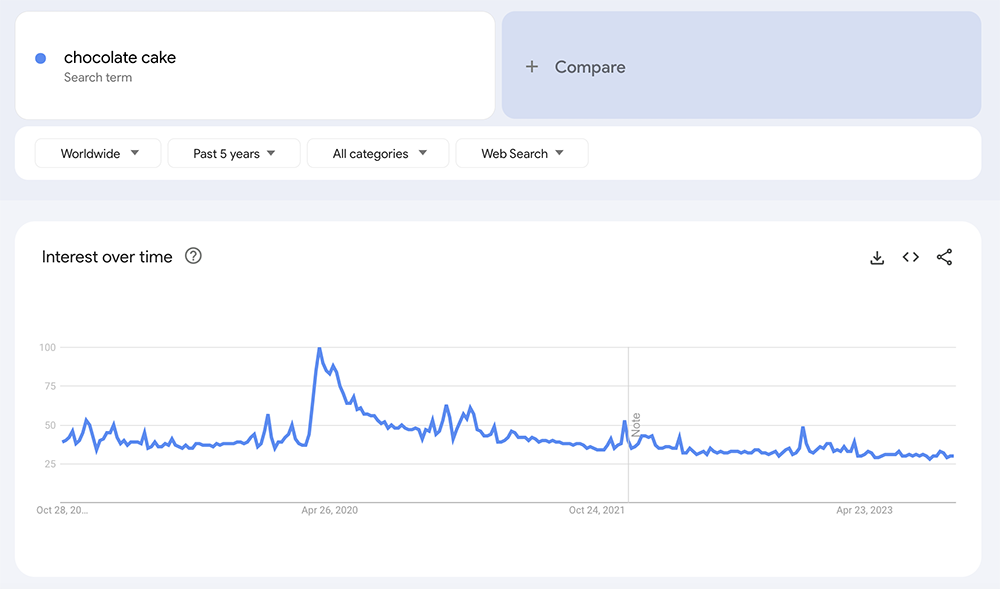
On the other hand, “chocolate zucchini cake” wouldn’t be considered evergreen due to the fact that demand surges around the holidays before dropping during the rest of the year.
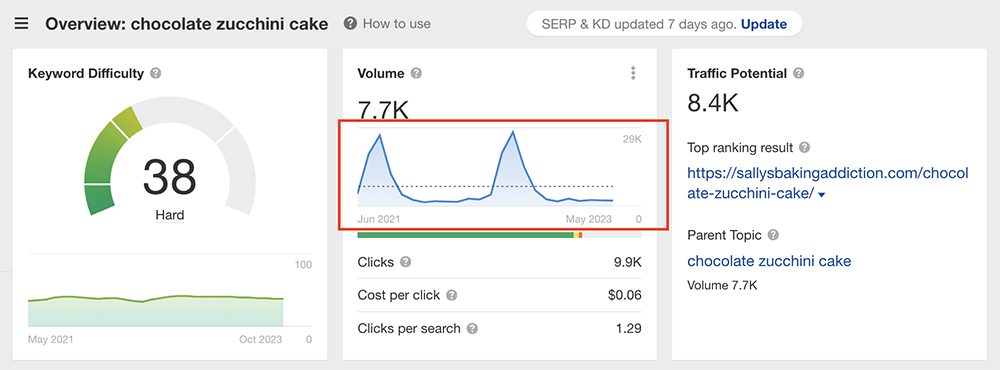
And here is how it looks on Google Trends.
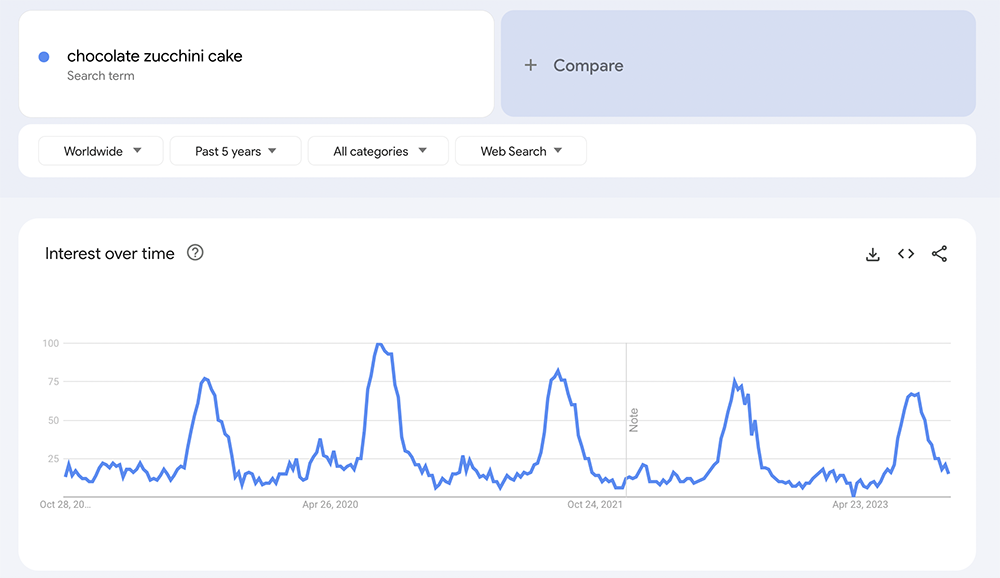
Step 2: Write Evergreen Content
After you’ve identified the evergreen topics and keywords relevant to your industry, the next step is to create the content for it. Here are the best practices that you should follow when writing evergreen content.
Address User Intent
Google wants to provide its users with the most relevant content for their queries. In order to rank for your desired keywords, you need to ensure that you’re addressing the search intent of the keyword(s) that you’re trying to rank for.
For example, when looking at the pages ranking for “chocolate cake”, you’ll notice that Google features recipes.
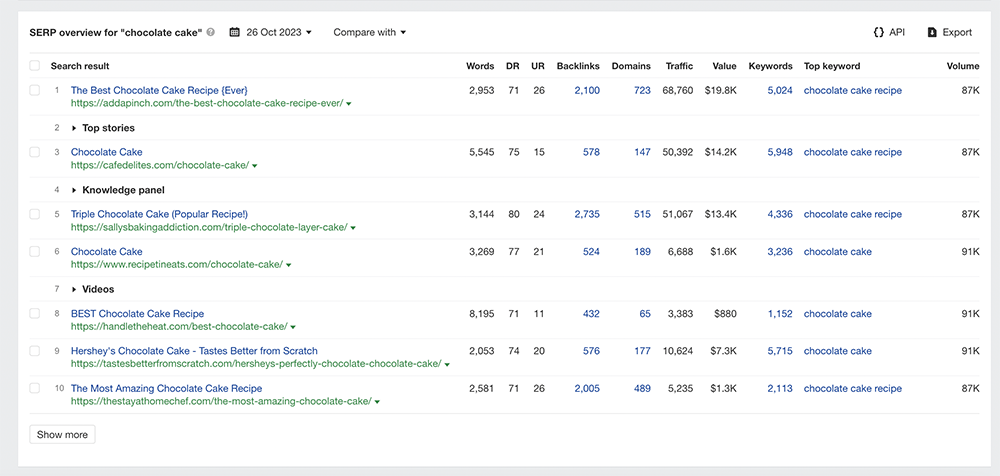
Be Comprehensive
Digging deeper allows you to identify what other keywords the top ranking pages for your main keyword are also ranking for. Doing so provides an insight into what the audience might expect to find and what content you should include within your own page.
You can do that by looking at the Content Gap.

From the below example, you can tell that searchers are looking for chocolate cake recipes that are “easy”, “homemade” and “from scratch”. So it’s important to ensure that your recipe (the content) addresses these needs.
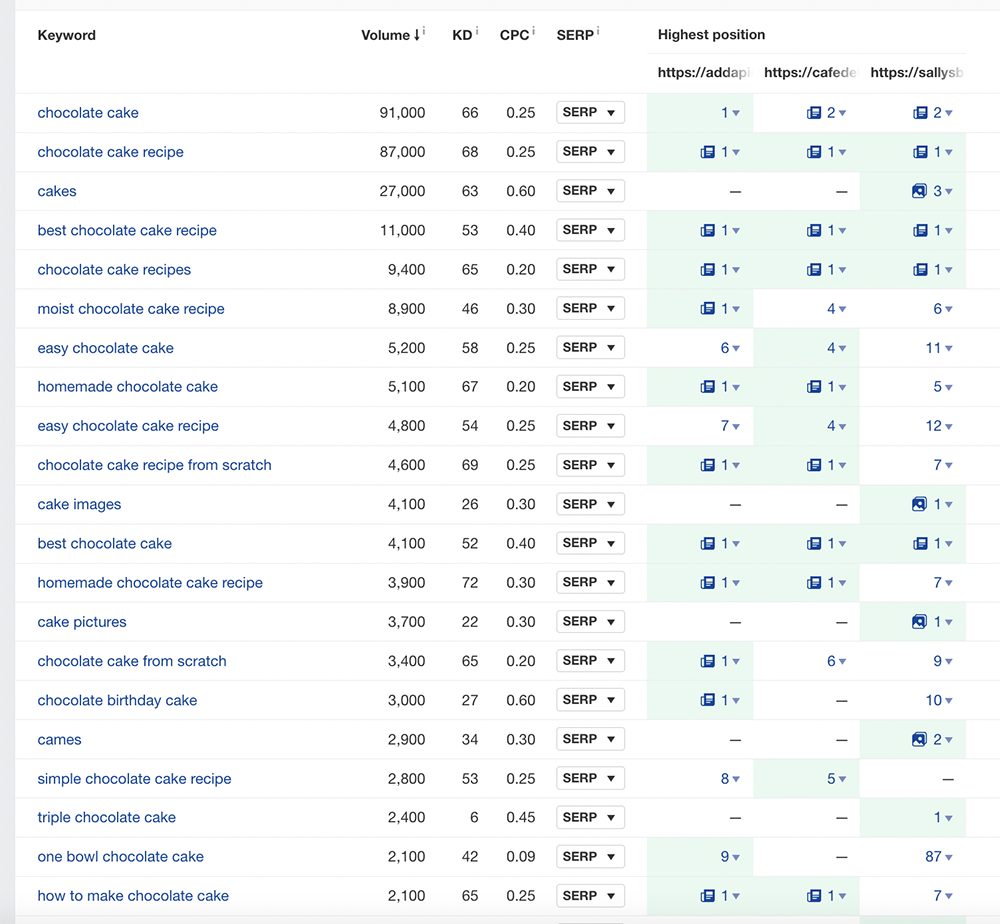
Be Unique
It might not always be possible depending on what you’re writing about, but if you have the opportunity, add a personal touch to your content by writing from personal experience. It will not only make your piece unique, but it might also help you connect with the reader.
On top of this, this will help future-proof your content from Google algorithm updates. In recent years, Google has focused on rewarding websites that demonstrate first hand experience within their content.
FAQs About Evergreen Content
Why Is Evergreen Content Important?
Evergreen content is important because it doesn’t lose its relevancy and will continue to generate traffic even years after being published. A quick Google search on many keywords will show results that were originally published years ago, yet they continue to rank because they have maintained their relevance. They’re the perfect example of evergreen content.
When you create evergreen content, you don’t have to create as many articles. News sites, or websites that rely on non-evergreen content, tend to write more of it than those who publish fewer articles, but their content is more universal.
Evergreen articles can also help you generate backlinks over a longer time. Since they continue to stay relevant as time passes, it means that they can generate backlinks for your website even years after you publish them. Not to mention that this helps them rank better, as Google sees that others want to link to that page due to the relevant content, especially if they come from authoritative websites.
What Are Some Common Evergreen Topic Examples?
Here are some of the most common evergreen content types, as well as some topic examples:
- How-to guides – How many times have you searched how to do something on Google? Probably quite a few. Google tends to be the main problem solver for many people, so take advantage of that by providing a solution to relevant “how to” questions related to your business/website.
- How to write a book
- How to cook chicken
- How to tie a tie
- How to make brownies
- Frequently Asked Questions – The best part of writing FAQ articles is that Google itself tells you what its users want to know in the form of “People Also Ask” section of the search results.
- FAQ about cutting your hair
- FAQ about travelling to a different country (should be updated in case regulations change)
- FAQ about buying a new car
- FAQ about furnishing an apartment
- “Everything you need to know about…” articles – This type of content is not only relevant, but it also gives you an opportunity to use one article to rank for several different keywords.
- Everything you need to know about mosquitos
- Everything you need to know about ChatGPT
- Everything you need to know about Kenya
- Everything you need to know about planning a wedding
- Lists and tips – This type of content is what readers are looking for when they are in need of quick and actionable information.
- X packing tips for your next trip
- X tools to have in your home
- X easy and quick recipes
- X ways to style a black shirt
- Glossaries – Glossaries are a great resource for those who want to become more knowledgeable in a particular topic. Depending on the number of words or phrases that should be included, it can be quite time-consuming, but it’s rather easy to do, as many definitions are already provided.
- Marketing jargon glossary
- Legal jargon glossary
- Medical jargon glossary
- Financial jargon glossary
What Isn’t Evergreen Content?
There are several types of non-evergreen content, but the most common examples include:
- News articles – Most news articles talk about a specific event and become irrelevant the moment the said event ends.
- Statistics and reports – The data used in them doesn’t stay the same, and they typically focus on a specific time period.
- Articles that focus on trends within a specific time frame – Good examples of that would be articles like “Best looks for 2023 fall” or “Best football teams to bet on this season.”
What’s the Difference Between Trending Topics & Evergreen Content?
The main difference is the relevancy. Trending topics tend to be relevant for a short period of time or during a specific time of the year, but evergreen content retains its relevance throughout the whole year.
The second difference between them is how they’re created, and the perfect example of that is news articles. In order to get your news article trending, you have to be on the pulse and get your content published fast in order to make the most of the search demand at the time. However, for evergreen content, you can afford to take your time as you can be confident that the interest for the topic will not deteriorate.
They also have different purposes. Non-evergreen content is meant to attract the reader’s attention at the given moment, while evergreen content focuses more on providing valuable information and educating the reader.
The Bottom Line
Evergreen content provides a great opportunity to create something that will bring results in the long term. The idea of evergreen content is that your pages will continue to attract readers even years after they’ve been published, bringing continuous traffic to your website.
More articles
View more of our research.

Constructing An eCommerce Website for SEO
Find out how to construct an eCommerce website that is great for users and accessible for search engines.

Educating Clients on the Value of SEO: A Guide for Marketing Managers
Find out how marketing professionals can transform their clients' perception of SEO by educating them about the value that it can bring to their businesses.
